I just got lost on Mars. I saw this intriguing image, above, on the HiRISE camera website, and ended up spending a large chunk of my morning just wandering through the dunes of Mars — actually wandering through images of dunes on Mars. These striking features have to be one of the most intriguing areas of study on the Red Planet since they are one of the most dynamic geologic processes going on currently on Mars.
The dark dunes are composed of basaltic sand, and scientists believe the dunes in the image above have formed in response to fall and winter westerly winds. Also superimposed on their surface are smaller secondary dunes that are commonly seen on terrestrial dunes of this size.
See below for more intriguing dunes on Mars that I came across in my wanderings…
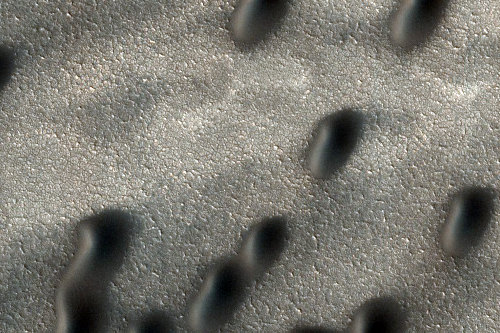
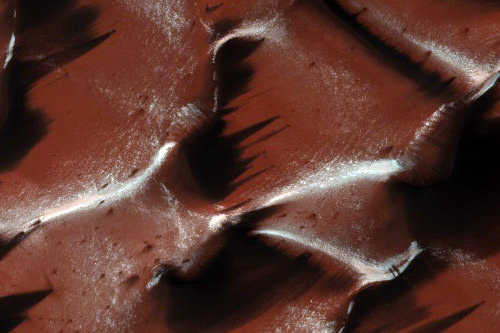
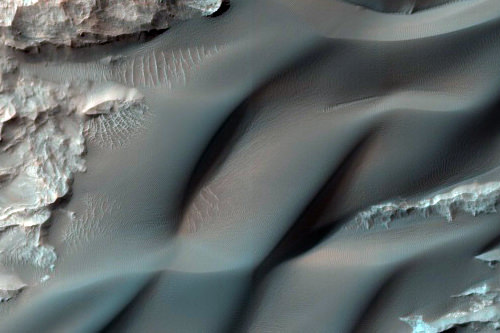
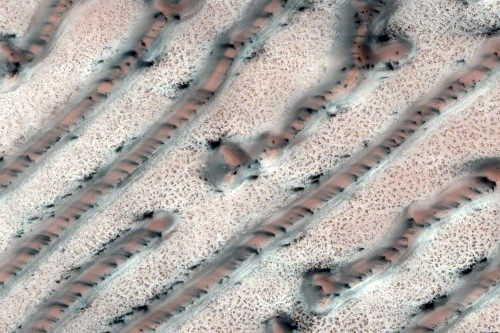
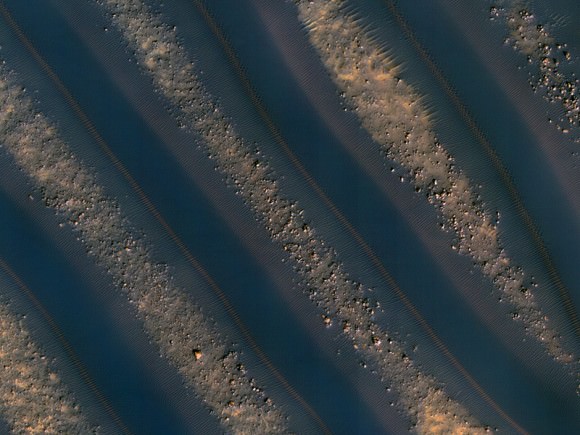
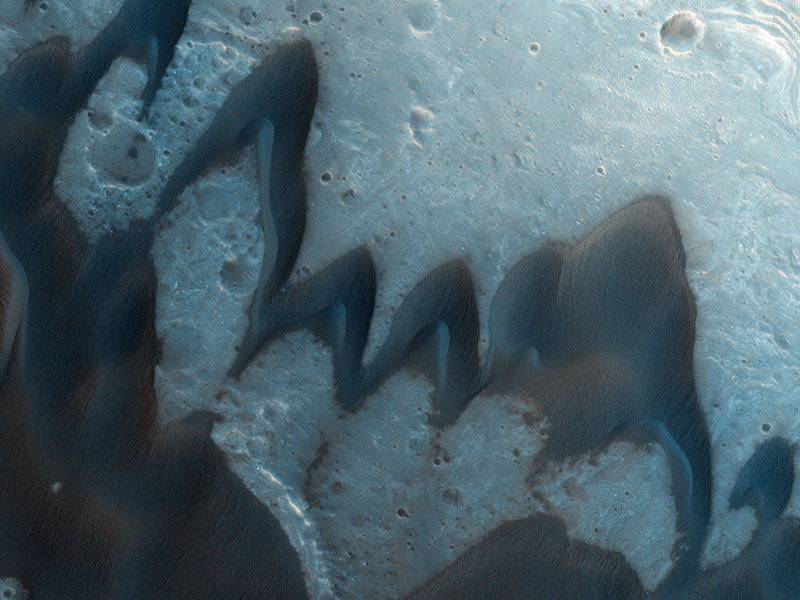
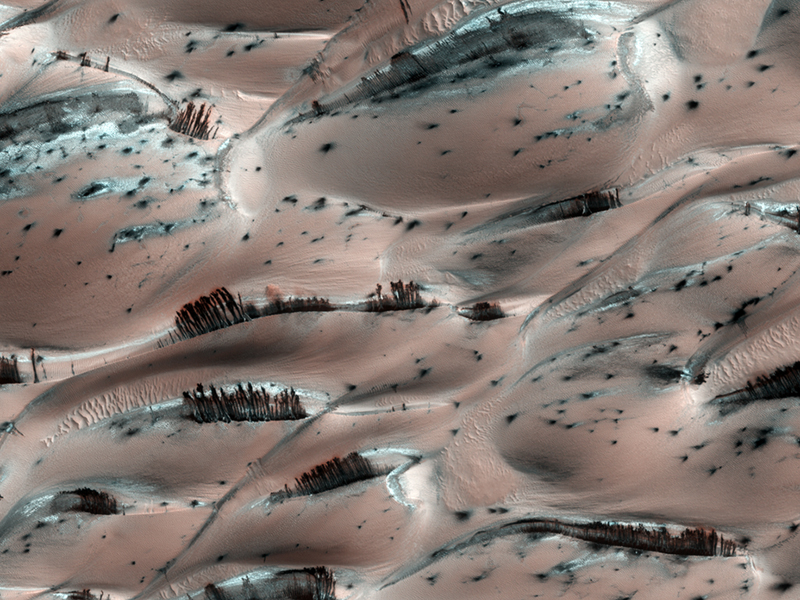
We’ve posted this image before, as it really is a weird-looking landscape, but it is worth seeing again.
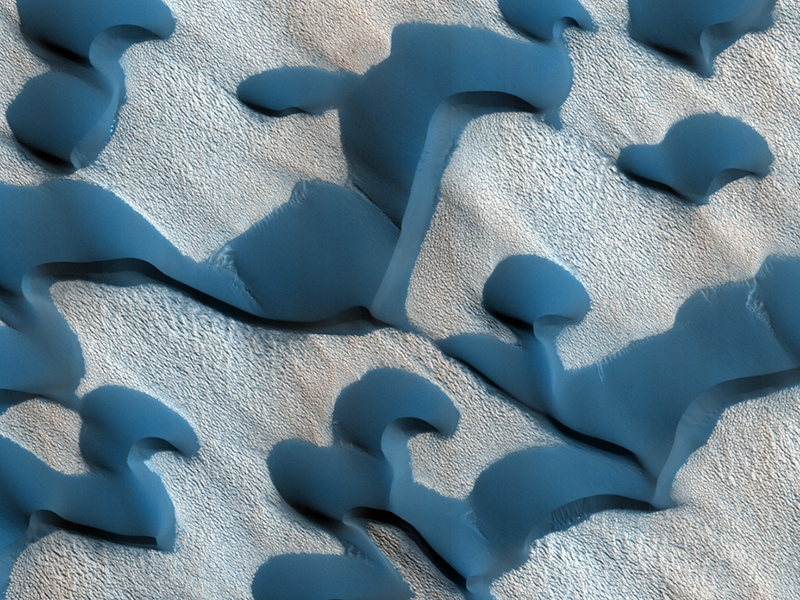
See more on the HiRISE website!

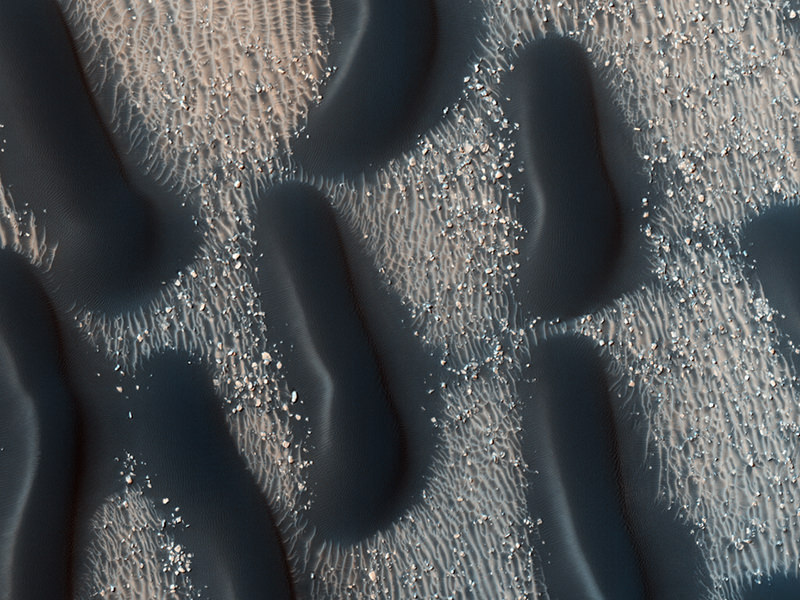
How much of Mars with HiRISE cover during its mission?
Fascinating! How did Frank Herbert know?
Conjures up a short story? A couple hundred thousand years ago: Aliens enter our system and find something valuable to them on Mars. They come to Earth and find several primate species flourishing. They select the more intelligent of the samples they’ve abducted and teach them how to operate machinery and work in vacuum suits. They take them to Mars to extract the ore they require. Later one of the Mars Rover’s comes across the remains of the abductee’s camp.
If that is chocolate dunes *I* will go on a one-way trip!
Obviously then the scientists are mistaken and the black dunes are licorice. Now all we need is the sugar dunes and coke springs, and we are set.
That’s how the Earth might one day look like. This requires a long explanation, and why not be a little sensationalist and title it…
Global Suffocation!
Nobody’s discussing “global suffocation”, and nobody’s ever even given it a name, yet long ago Harlow Shapley, the astronomer who discovered that we’re off-center in the galaxy, in the second section of his fourth essay in Beyond the Observatory (1967), made some comments that lead one to realize that there is such a risk, but maybe only in the long run, and especially if there’s a worldwide increase in volcanic activity.
Oxygen is very reactive, so that if all plants were to disappear then the free, that is, atmospheric oxygen, would soon vanish, too, by bonding with the elements in the rocks. The process is quicker in ages with uncommonly active volcanos since these spew out large amounts of unoxidized stuff. This is what might’ve happened in Mars, where the formerly free oxygen oxidized the surface and turned it red.
Two circumstances are promoting a “mars-ification” of Earth: desertification and deforestation. Even Costa Rica, a country that is now taking due care of its natural habitats, changed its ways when it was already too late. Half a century ago it was almost entirely covered by its forests. Now these are mere isolated patches. The most recent Big Idea is gradually to reconnect those patches with broad lanes so that plants and animals will once again come and go between them. This is a gigantic enterprise and nobody seems to be in a hurry to get the job done. Actually the opposite is happening in equatorial regions, in places like Brazil, Indonesia and Colombia, due to overpopulation.
We won’t find ourselves gulping air like fish out of the water anytime soon, but this is turning into a secular tendency. It could happen in the course of the next few centuries, or it could take more like a thousand or two thousand years. Nobody’s being a scaremonger here. Those who live high above sea level will be able to adapt quicker to the new atmosphere since animals compensate for the thinner air by increasing the concentration of red blood cells, which are oxygen carriers. Maybe eventually we’ll have to go around with oxygen tanks on our backs, like skindivers. Only the rich would be able to afford it. Others would simply suffocate.
Shapley never contemplated anything of the sort. He was discussing other matters, like why argon is the third most abundant gas in the terrestrial atmosphere. He belonged to a healthier, more optimistic world, as the following passage shows: “(…) oxygen is (…) growing in amount as the spread of vegetation over the Earth’s surface increases. This spread may not be increasing rapidly at present because of the creeping deserts, but if the ingenuity of man [“humankind”, we would now say] changes the vast deserts (one-third of all land areas) to forests and green fields, photosynthesis will increase the atmospheric oxygen, absolutely and relatively.”
The Israelis are showing the way, but will they ever be able to turn their Negev Desert into a “breadbasket”? After more than 60 years of trying it still covers the entire southern half of their Problematical Land.
@Daniel Rey M. : I think the actual term is ‘desertification’?
http://en.wikipedia.org/wiki/Desertification
Which as you know, is the process where massive top soil erosion occurs due to any number of natural disasters including overpopulation, deforestation, flooding due to deforestation or climate change, soil nutrient depletion, over fertilizing, aquifer contamination/damage – salt water migration, industrial spill or?
http://pubs.usgs.gov/gip/deserts/desertification/
Satellite images of dust storms over China crossing the Pacific or from Africa crossing the Atlantic, of from India into the Indian Ocean come to mind…
http://www.nasa.gov/multimedia/imagegallery/image_feature_989.html
http://science.nasa.gov/media/medialibrary/2001/05/14/ast17may_1_resources/asia_dust_storm_full.jpg
http://theintrepid.blogspot.com/2009/09/satellite-view-of-dust-storm-over.html
http://earthobservatory.nasa.gov/NaturalHazards/view.php?id=42446
http://www.news.com.au/national/skies-in-queensland-nsw-go-red-in-dust-storm/story-e6frfkvr-1225778535143
Quite the ‘rogues’ gallery’ that.. eh?
According to the Mayan calendar we are all going to perish in 2012, so hopefully the trees can keep generating just enough oxygen for the rest of us to breath until then. If that doesn’t come to pass, perhaps aliens, planet X or some other catastrophic event will wipe us out.
Seems to me that most of the worlds governments are waiting for science to bail them out on the environment. Hoping that one day someone will create some process by which we can clean the water, air land, etc…without having to actually having to physiccally do it themselves. I wouldn’t hold my breath to long waiting for anyone to step up and do anything to curb overpopulation, overuse of resources or the polluting of the planet.
No, that calendar does not end in December 2012, nor does it predict the end of humankind. It talks about a neverending cycle with upheavals between eras. This is similar to the Christian myth, if that’s what it is –my apologies if it’s a truthful account, or at least partly so– described in the Book of Revelation or Apocalypse, but this other story is a once-only affair. No longer do we need prophets to warn us since science has been doing it in the last few decades, to no avail. They are the present-day Cassandras, and they, too, are being ignored (by the profiteers).
Worry not about extraterrestrials. They don’t interfere. They just watch, like voyeurs.
If you look at earth, you will see the effects of biological life everywhere, it affects the landscape like a fingerprint over the underling geology.
The black dunes of mars are the only comparable observed feature that could come close. A testable hypothesis for the dunes as a biological entity is proposed:
http://www.colbud.hu/esa/publications/13_szathmary.pdf
I would strongly advocate testing in the next Mars rover mission. A correlation between Dune concentrations and methane production would be a huge step forward for the hypothesis.
Fascinating Stuff!
@ Daniel: Yes, no and no.
Yes, the atmosphere oxygen is a sign of imbalance from biologically liberated oxygen.
No, we won’t become Mars. First we now differ significantly in minerals (~ 44 % of which types are biological) and tectonics (we still have one due to our oceans). Second we have a matured atmosphere which have a significant hydrogen deficit. I don’t think anyone have run down a simulation, but photolysis would still liberate oxygen in significant amount. No Mars.
No, we won’t suffocate from deforestation. ~ 70 – 80 % of oxygen is believed to be produced in the oceans still.
It is funny how such misconceptions are born.
“Common knowledge” is that life is mostly cellular. But viruses outnumber cells ~ 10:1 by way of oceans.
“Common knowledge” says that cellular life is mostly multicellular. But unicellulars outmasses multicellulars ~ 100:1 or so. Heck, most DNA in our bodies are unicellular symbionts, by roughly that rate.
“Common knowledge” says that multicellular plants provide oxygen. But see above.
The problem “common knowledge” faces here is that the biosphere has a history that needs to be taken into account despite everyday life appearances. Life started out as stromatolite biofilms. Hence most biomass is still produced in such. Likewise for algae vs later plants. New diversifications may find smaller niches to play around in, but they will never displace the existing most productive ones.
[Viruses may be the exception. Then again, if life started out as RNA world type hereditary elements on a background of haphazard metabolic production, they may look awfully like the first selfish genes, the first classically darwinian population.]
@ Kammueller:
Which of them, there is no _the_ Mayan calendar since each city state had their own variant (this is known) and likely several over their history as we have (my speculation, since I don’t fell like checking that one).
Out of the then tens, hundreds or perhaps thousands of calendars you can pick some which displays a symbol that is believed to mark the necessary reset of the calendar, similar to our New Year’s Eve. But it is less certain, the symbol (piktun) is haphazardly used, it is a controversy if it really stands for 13 as the 2012 story demands (reset after 14 b’ak’tuns) or 20, and is not the more usually used Long Count format.
As Daniel Rey M notes this cycle reset has been tied to a myth story, which isn’t all that pervasive in Mayan culture I believe (see the different calendars above!), and the connection is a modern day invention without any evidence behind AFAIU.
But all of this is described even in the Wikipedia entry on the mayan calendar, so it is curios how anyone fail to check this before commenting confabulations on a science blog.
Rejected by modern statistics on biological diversity, no planet X (or galactic disk) is lobbying extinction causing comets at us. I can provide the reference if asked.
The first figure intrigues me. The ice there looks to be a very complicated filigree of crystals. The scale eludes me though. I wonder what this would look like close up, say if I were standing on one of those black dunes.
Earth in the long run will not become like Mars, but more like Venus. The increased output of solar radiation in the main sequence evolution of the sun will by a billion years from now begin to make complex life here difficult. Two billion years from now the oceans will have boiled away and the collapse of life will convert the environment here into a Venus landscape. Earth will have a dense atmosphere largely made of CO_2 with a temperature around 400 deg C.
LC
With the first picture you can see multiple slit wave physics. The large black dunes play the role of a mask and the small dunes laced with frost or snow play the role of waves. These are obviously both generated by winds, and so the smaller ripples act as waves against the larger black dunes. You can see slit diffraction and some wave interference as a result.
LC
Torbjorn Larsson Om, you say that ” No, we won’t suffocate from deforestation. ~ 70 – 80 % of oxygen is believed to be produced in the oceans still.” This is an allusion to the oxygen released by phytoplankton, I guess. When I said “if all plants were to disappear” I was including that type of plankton, in accordance with the simple, traditional three-kingdom classification they used to teach in the natural sciences –mineral, plant and animal kingdoms– before the electronic microscope allowed a closer inspection and led to the discovery of the difference between eukariotic and prokariotic cells, so that now they tell us it’s five and not three: Monera, Protista, Fungi, Plants, Animals.
The oceans, too, including its plankton, are being destroyed by toxic contamination. You probably live or lived not too far from where Thor Heyerdahl’s raft, the Kon-Tiki, is displayed (in Oslo). When he first crossed the ocean on it about 60 years ago he found it in a healthy condition. Many years later, during his first Ra expedition, the situation had changed drastically. He found black oil pellets floating everywhere. There’s also plastic rubbish now. Some transoceanic travellers say that sometimes they find themselves surrounded by it for weeks and weeks, in the high seas, far removed from the nearest coast.
I mean to say, “five and not just two anymore”, as far as living entities are concerned.
Fair enough, though there are still oxygenating photosynthesizers like cyanobacteria. I’m not a fan of Linnean classification, preferring cladistics. (In which case we are all bacteria, of course! (O.o) )
You simply can’t knock out all life before you knock out the less robust waste producers. In that process it isn’t suffocation we will die of, more likely starvation.
In any case, there is no large scale “toxic contamination”. Deforestation is a product of land use. Oil and plastic is feeding bacteria as we speak. Problems for phytoplankton is too much nutrients (so they bloom and then die), fishing (so the protists eating them either explode or implode in numbers, depending on the food chain), AGW, and so on and so forth. Toxicity of waste is a minor irritant, if that.
…so, in other words, the broad base of the food chain is indestructible. It thrives on poison. There’s no way we can run out of free oxygen. Very reassuring! On the other hand, maybe something unexpected will come up, like volcanos exploding all over the place and dumping so much unoxidized matter on the surface of the planet that photosynthesizers will no longer be able to release oxygen quickly enough to compensate for the loss of free oxygen. I wonder what other scenarios could bring down the free oxygen concentration to dangerous levels.
“Toxic contamination” sounds redundant and I think it would’ve been better to say something like “toxic substances”. Contamination always involves toxicity, I think. Also, one has to bear in mind that only inanimate matter, like a glass of milk, gets contaminated, and only living organisms get infected. A glass of milk doesn’t get “infected”, a person doesn’t get “contaminated”. It’s the kind of things that medical encyclopedias point out.
@Torbjorn Larsson OM …. Your comment, “No, we won’t suffocate from deforestation. ~ 70 – 80 % of oxygen is believed to be produced in the oceans still.” Does not address what deforestation does to the world’s oceans… OR how overpopulation’s use of hydrocarbons is changing the Ph of the oceans!
Yes, and it’s unfortunate that Torbjorn’s comments are precisely what makes irresponsible and predatory transnational companies happy to hear and what the conservative “think tanks” they finance like to divulge. Moreover, experts, too, can make mistakes since there’s always the chance that something is being overlooked. The imponderables can utterly wreck even the most carefully laid out plans. Whatever the case, we can’t just sit back and wait for the microörganisms to gobble up all that oil and plastic. They are being overwhelmed. And what about the really nasty stuff, like dioxin, the heavy metals and DDT?
I keep wondering whether or not anybody has come up with a list of dramatic circumstances that would rob the atmosphere of its oxygen and drag it to dangerously low levels…and also what could be done to replenish it on time, before it’s too late. This is a job for futurologists. Anyway, our resident expert seems to have gone on vacations….
“NASA reports that in the north Pacific Ocean oxygen-producing phytoplankton concentrations are 30 percent lower today, compared to even the 1980s. This is a huge drop in just three decades.” (From a report at ChinaDaily.com.cn titled “Global oxygen level falling, warn scientists”)
This contradicts the assertion that the foundation of the marine food pyramid is invulnerable. Are we being deliberately thrown off the track?